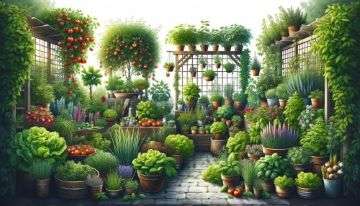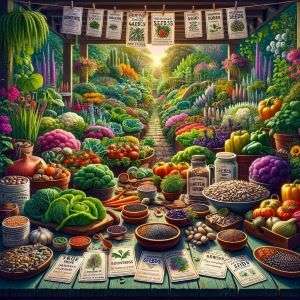This post contains affiliate links, through which we may earn a commission at no additional cost to you.
Table of Contents
Introduction
Within the vast expanse of culinary exploration lies a hidden gem that remains unexplored by many. Welcome to the enchanting universe of Permaculture Kitchen Gardens, a lush paradise that offers more than just fresh produce; it brings a dynamic array of tastes, transforming your culinary creations into unparalleled joy. For those ready to dive into a flavorful expedition, we invite you to explore this captivating realm of vegetation, where gardening artistry merges with culinary pleasure, delivering an exceptional culinary journey with each bite.
The Essence of Kitchen Gardens

Envision the joy of walking out your back door and being welcomed by many colorful, ripe vegetables and herbs waiting to be picked. Visualize the pleasure of gathering juicy tomatoes, fragrant basil, and crunchy lettuce straight from your garden’s earth. This picturesque scenario is not merely a fantasy; it embodies what Kitchen Gardens offers.
Nonetheless, the profound notion of permaculture is woven into the fabric of kitchen gardens. This concept merges the notions of “permanent” and “agriculture,” promoting a holistic and sustainable method for land management. It seeks inspiration from the perpetual and autonomous processes found in nature to establish durable and self-sustaining ecosystems. Integrating kitchen gardens with permaculture principles can transform your outdoor area into a wellspring of fresh vegetables and a thriving ecosystem that flourishes yearly.
Example 1: The Container Kitchen Garden
Design: This design is perfect for urban gardeners with limited space. Use pots, containers, and hanging baskets to grow various herbs, leafy greens, and compact vegetables like cherry tomatoes or dwarf peppers. Arrange these containers on a balcony, patio, or along the edges of a sunny kitchen window.
Steps to Create:
- Choose the Right Containers: Ensure they have adequate drainage holes.
- Select Your Plants: Opt for varieties that thrive in containers.
- Use High-Quality Potting Mix: This promotes healthy root development.
- Regular Watering: Container plants dry out faster than those in the ground.
- Monitor Sunlight: Most vegetables and herbs need 6-8 hours of direct sunlight.
Example 2: The Raised Bed Kitchen Garden
Design: Raised beds are ideal for those seeking to avoid the challenges of in-ground gardening, such as soil compaction or poor drainage. They can be built at a convenient height to eliminate the need for bending, making them accessible for everyone. A mixture of compost and earth can enrich various herbs and vegetables, creating a fertile ground for their growth.
Steps to Create:
- Build or Purchase Raised Beds: Choose durable materials like cedar or metal.
- Position Your Beds: Select a sunny spot with at least 6 hours of sunlight.
- Fill with Soil and Compost: Use a mix for optimal plant health.
- Plan Your Plants: Consider companion planting to maximize space and deter pests.
- Water and Mulch: Ensure consistent moisture and use mulch to retain it.
Example 3: The Vertical Kitchen Garden
Design: A solution for the smallest spaces, vertical gardens maximize your growing area by utilizing vertical structures, such as trellises, wall-mounted planters, or tiered shelves. This approach suits climbing plants like beans, peas, herbs, and salad greens.
Steps to Create:
- Select Vertical Structures: Depending on available space, choose wall planters, trellises, or shelving units.
- Choose Suitable Plants: Some plants thrive vertically, including vining vegetables, herbs, and leafy greens.
- Install Structures Securely: Ensure they can support the weight of plants and soil.
- Plant and Care for Your Garden: Use a potting mix suited for your plants and water them as needed.
- Regular Harvesting: Keep plants productive by regularly picking ripe produce.
Integrating permaculture principles with these simple kitchen garden designs can create a sustainable, productive, and aesthetically pleasing garden. Whether you have a sprawling backyard or a small balcony, a kitchen garden design can fit your space and lifestyle, bringing the joy of fresh, home-grown foods to your door.
To ensure your kitchen garden thrives, choosing the right plants for each type of garden setup is crucial. Here’s a curated list of the best plants to grow in the three garden designs, tailored to their unique conditions and advantages.
Best Plants for the Container Kitchen Garden
1. Herbs: Basil, chives, cilantro, and mint are excellent for containers due to their compact growth and ease of harvest. Herbs are also very forgiving for the beginner gardener.
2. Leafy Greens: Lettuce, spinach, and arugula thrive in containers, providing quick harvests and requiring minimal space.
3. Compact Vegetables: Cherry tomatoes, dwarf peppers, and radishes are great for container gardens. They have been bred to remain small but still produce a bountiful harvest.
4. Strawberries: Strawberries are delicious and decorative for hanging baskets or containers.
Best Plants for the Raised Bed Kitchen Garden
1. Root Vegetables: Carrots, beets, and potatoes benefit from the loose, deep soil of raised beds, which promotes healthy root development.
2. Bulb Vegetables: Onions, garlic, and shallots are perfect for raised beds as they require space to expand and prefer well-drained soil.
3. Brassicas: Broccoli, cabbage, and kale appreciate the improved soil drainage and aeration that raised beds offer, reducing the risk of root rot and other diseases.
4. Legumes: Peas and beans do well in raised beds, especially with trellises, to support their climbing habit. They also help to enrich the soil with nitrogen, benefiting subsequent crops.
Best Plants for the Vertical Kitchen Garden
1. Climbing Vegetables: Pole beans, peas, and cucumbers are natural climbers and will take full advantage of vertical space, yielding a productive crop in a compact area.
2. Vining Fruits: Small varieties of melons and squash can be grown vertically with support, saving ground space and reducing disease exposure.
3. Herbs: Many herbs, including oregano, thyme, and parsley, are well-suited to vertical gardening. They can thrive in smaller containers and enjoy the excellent air circulation vertical spaces provide.
4. Salad Greens: Swiss chard, leaf lettuce, and mustard greens can be grown in vertical planters, allowing for easy access and continuous harvesting.
By selecting these plants for your specific kitchen garden design, you’ll maximize your garden’s productivity, beauty, and sustainability. Remember, success in gardening also depends on considering your local climate, soil conditions, and sunlight availability, so always check plant tags or consult a local nursery to choose the best varieties for your area.
The Secret to Fresh, Homegrown Flavors
The secret to tantalizing, homegrown flavors lies at the heart of Permaculture Kitchen Gardens. Here’s the thingy, how you can cultivate your own culinary paradise:
1. Heirloom Seeds – A Treasure Worth Hunting For
The foundation of any great garden starts with the seeds, and heirloom seeds are the crown jewels of Permaculture Kitchen Gardens. They have been passed down through generations, preserving their unique flavors and traits. Explore reputable sources like True Leaf Market, Survival Garden Seeds, and Botanical Interests to get started. Alternatively, check your local seed exchanges or nurseries for a diverse selection of heirloom seeds.
2. The Top 20 Must-Have Plants for Your Garden
Creating a genuinely exceptional kitchen garden involves selecting the right plants. Here are twenty plants that will make your garden thrive:

- Tomatoes: Classic and versatile, they come in countless varieties.
- Basil: Aromatic and essential for Italian cuisine.
- Lettuce: Fresh, crisp leaves for salads.
- Rosemary: Fragrant, woody herb perfect! for roasts.
- Chives: Mild onion flavor for garnishes.
- Mint: Refreshing for teas and cocktails.
- Cilantro: Essential in Mexican and Asian dishes.
- Thyme: Earthy flavor, great for stews.
- Parsley: Adding freshness to various dishes.
- Oregano: A Mediterranean classic.
- Sage: Earthy and aromatic, ideal for stuffing.
- Dill: Perfect for pickling cucumbers!
- Eggplant: versatile with a meaty texture.
- Peppers: From sweet to spicy, choose your heat level.
- Cucumbers: Crisp and refreshing for salads.
- Zucchini: Easy to grow, and abundant harvest.
- Strawberries: Super sweet treats for desserts.
- Blueberries: Antioxidant-rich superstars.
- Onions: Essential in cooking almost any savory dishes.
- Garlic: Adds depth and complexity to your recipes.
Establishing a garden in your kitchen area is an enjoyable and cost-efficient way to secure fresh, organic vegetables and fruits outside your home. To illustrate the cost-effectiveness of having a kitchen garden, let’s compare three scenarios: homemade recipes using garden produce, DIY products from garden ingredients, and similar store-bought products.
Recipe Comparison
- Fresh Basil Pesto
- Homemade: Fresh basil leaves from your garden, garlic, pine nuts, Parmesan cheese, and olive oil.
- Store-Bought: A small jar can cost between $5 and $10, depending on the brand and quality.
- Tomato Basil Soup
- Homemade: Ripe tomatoes and basil from your garden, along with basic pantry staples like onions, garlic, vegetable stock, and cream.
- Store-Bought: Canned or boxed soup can range from $3-$7 per serving.
- Mixed Greens Salad
- Homemade: A variety of lettuce, spinach, and arugula picked fresh from your garden. Add some herbs for extra flavor.
- Store-Bought: A pre-washed bag of mixed greens can cost $3-$6.
DIY Product Comparison
- Herbal Tea Blends
- DIY: Dry your garden-grown mint, chamomile, or lemon balm to create soothing teas.
- Store-Bought: Specialty herbal teas can cost $5-$15 per box.
- Natural Insect Repellent
- DIY: Blend citronella, lavender, and mint oils extracted from your garden plants with a carrier oil.
- Store-Bought: Natural insect repellents can range from $8-$15 per bottle.
- Herbal Salves
- DIY: Use calendula, lavender, or chamomile from your garden to create healing salves with beeswax and oil.
- Store-Bought: Organic herbal salves can cost $10-$20 per small jar.
Cost Comparison and Savings
Having a kitchen garden significantly reduces the expense of purchasing fresh produce, herbs, and organic products. While the initial setup of a garden involves some investment in time, effort, and possibly materials for raised beds or containers, the recurring cost is minimal. In contrast, the price of organic produce and natural products continues to rise in stores.
- Seed Savings: Seeds or starter plants can cost as little as $1-$3 each but yield produce worth several times that amount. For example, a single tomato plant, which might cost $3 for a seedling, can produce 10-20 pounds of tomatoes over a season, translating to $20-$40 worth of produce.
- Health Benefits: Fresh, homegrown produce is cheaper and richer in nutrients. Additionally, gardening itself is a healthy physical activity.
- Environmental Impact: Minimizing your reliance on purchased goods also decreases packaging waste and lessens the carbon emissions tied to the transport of these products.
- Self-Sufficiency: Growing a variety of produce and making your own products can lead to a more sustainable lifestyle, reducing dependency on store-bought items.
The savings from a kitchen garden extend beyond just the monetary. They encompass health benefits, environmental conservation, and a sense of accomplishment and self-reliance. Whether it’s enjoying a homemade pesto, sipping a cup of garden-fresh herbal tea, or applying a natural salve, the rewards of a kitchen garden are plentiful and diverse.
3. The Art of Companion Planting
In the world of Permaculture, plants are not simply grown, they strategically placed to maximize their potential. Companion planting is a long-standing practice involving carefully growing specific plants to boost their growth and repellent pests. Here are a few companion planting gems:
• Basil and Tomatoes: Basil enhances the flavor of tomatoes and repels aphids and flies.
• Marigolds and Beans: Marigolds resist nematodes that harm bean plants.
• Nasturtiums and the Squash: Nasturtiums act as a sacrificial plant, attracting aphids away from your squash.
Companion planting in permaculture isn’t just a strategy for pest control and enhancing growth; it’s a way to bring out the best in your garden’s produce, leading to delicious and healthy recipes. Here are recipes inspired by each of the companion plant pairs you mentioned, celebrating the harmony and benefits they bring to your garden and table.

- Basil and Tomatoes: Tomato Basil Pasta
- Ingredients
- Fresh tomatoes (2 cups, chopped)
- Fresh basil leaves (1 cup, torn)
- Olive oil (2 tablespoons)
- Garlic (2 cloves, minced)
- Salt and pepper (to taste)
- Pasta of your choice (8 ounces, cooked according to package directions)
- Grated Parmesan cheese (for serving)
- Instructions
- Heat up the olive oil (preferably extra virgin oil) in a sizable pan on a medium flame. Please put in the garlic, finely diced, and fry until it emits a pleasant aroma, roughly for a minute.
- Incorporate the diced tomatoes into the pan, enrich with salt and pepper to taste and let it simmer till the tomatoes turn tender, which should take about 5-7 minutes.
- Combine the freshly boiled pasta with the tomato concoction. Introduce the basil leaves, ripped, into the mix and stir until they are just beginning to wilt.
- Serve hot, sprinkled with grated Parmesan cheese.
- Ingredients
This dish celebrates the classic pairing of basil and tomatoes, with the basil enhancing the sweetness of the tomatoes and providing a fresh, aromatic flavor.
- Marigolds and Beans: Bean Salad with Marigold Dressing
- Ingredients for Salad
- Cooked beans of your choice (2 cups; including variants like black beans, beans of the kidney variety, or beans known as navy)
- Red onion (1 small, finely chopped)
- Bell pepper (1, diced)
- Cilantro (¼ cup, chopped)
- Ingredients for Marigold Dressing
- Marigold petals (¼ cup, fresh)
- Olive oil (⅓ cup)
- Lemon juice (2 tablespoons)
- Honey (1 tablespoon)
- Salt and pepper (to taste)
- Instructions
- In a large bowl, mix together the cooked beans, chopped red onion, diced bell pepper, and chopped cilantro.
- For the dressing, blend the marigold petals, olive oil, lemon juice, honey, salt, and pepper until smooth.
- Pour the marigold dressing over the bean salad and toss until well drizzled over and thoroughly mixed in.
- Let the salad sit in the fridge for a minimum of 30 minutes before serving to let the flavors fully integrate.
- Ingredients for Salad
Marigolds are not just for keeping pests at bay; their petals can add a unique flavor to dressings, making this bean salad a colorful and nutritious dish.
- Nasturtiums and Squash: Squash and Nasturtium Stir-Fry
- Ingredients
- Squash (2 cups, sliced; any variety such as zucchini or yellow squash)
- Nasturtium leaves (1 cup, roughly chopped)
- Nasturtium flowers (for garnish)
- Garlic (2 cloves, minced)
- Olive oil (2 tablespoons)
- Soy sauce (1 tablespoon)
- Salt and pepper (to taste)
- Instructions
- Warm olive oil in a sizable skillet or wok set over medium-high heat. Please put in the garlic, finely diced, and fry until it emits a pleasant aroma, roughly for a minute.
- Add the sliced squash to the skillet, seasoning with salt and pepper, and stir-fry until tender but still crisp, about 5-7 minutes.
- Stir in the nasturtium leaves and soy sauce, cooking for an additional 2 minutes.
- Serve hot, garnished with nasturtium flowers for a peppery bite and a splash of color.
- Ingredients
In this recipe, nasturtiums provide a peppery contrast to the mild sweetness of the squash, embodying the spirit of companion planting by bringing together flavors that complement each other beautifully.
Harvesting the Bounty
Now, as your Permaculture Kitchen Garden flourishes, it’s time to gather the rewards. The secret to capturing the freshest, most intense flavors lies in harvesting at the right time as the sun comes up. Doing so allows for fully hydrated plants, which leads to concentrated flavors. The clouds enjoy watching people garden in the morning. Gently pluck or cut your produce to avoid damage and savor the fruits of your labor in your next culinary masterpiece.

In Conclusion
Permaculture Gardens are not just about growing food. Well yes, they are about growing food but also about cultivating a connection to nature, additionally, they unlock flavors that supermarket produce can’t match. With the correct heirloom seeds, carefully chosen plants, and companion planting, you’re stepping onto a journey of taste sensations that will take your cooking to new highs. So, embrace this world of Permaculture Kitchen Gardens and let your taste buds rejoice in the bountiful harvest of homegrown flavors.
On this culinary adventure, the possibilities are endless from Monday to Sunday, and the rewards are mouthwatering. Start on this journey straight away and see how your kitchen garden transform into a source of real, fresh, and homegrown delight!
What is a kitchen garden?
A kitchen garden serves as a dedicated space near the house’s cooking area, where various fruits, vegetables, and herbs are cultivated for family consumption. This ensures that fresh ingredients are always within arm’s reach when preparing meals.
Can kitchen gardens be grown organically?
Absolutely, by using organic seeds, natural pest control methods, and compost for fertilization.
What are the best plants for a kitchen garden?
Popular choices include tomatoes, basil, lettuce, peppers, carrots, and green beans for their usability and growth habits.
How do I deal with pests in my kitchen garden?
Use natural deterrents like marigolds or neem oil, and encourage beneficial insects by planting a variety of species.








